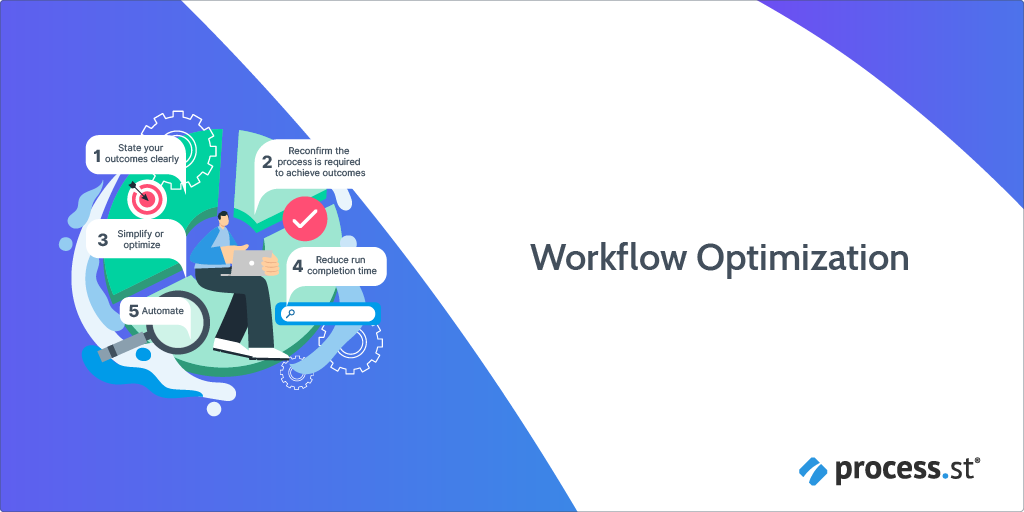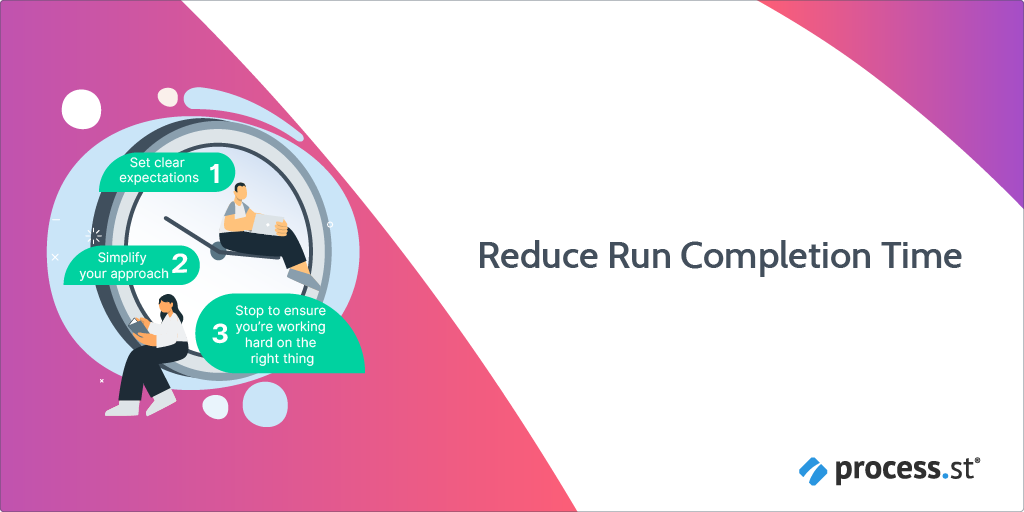
McDonald’s is the master of workflow optimization.
They sell 2.36 billion hamburgers annually. While at college, I estimate I made at least 200,000 when I worked for them. Every one of those burgers was a process involving many tasks. In the kitchen, we had lots of processes. They were difficult to forget, and I’d often wake up shouting, “How many nuggets do you want?!”
McDonald’s processes are continually improved and optimized to be smoother and more efficient. I once discovered a technical – yet easy – process that saved me a lot of work. What was it? At the end of the article, I’ll tell you how I used a 5 step process to complete it.
In the meantime, let’s look at how Process Street can help optimize your workflows. To use workflow optimization, you need to know:
- What is workflow optimization?
- How do you optimize a workflow?
- Optimize your workflows with automation
What is workflow optimization?
Workflow optimization is streamlining your current workflows to make a process faster, cheaper, smoother, and more efficient. An optimized workflow increases an organization’s success and utilizes resources more effectively.
Your workflow is a list of your most essential tasks that you work through one by one. It’s a list of your recurring processes. If you’re still using paper for a visual representation, you probably refer to this process as your daily checklist.
Successful workflow optimization is all about determining which tasks in a process are most crucial for business growth. How can the process be improved, which tasks can be eliminated without impacting final output, and how can documentation be made clearer?
What are the benefits of workflow optimization?
Optimizing workflows gives you greater agility. Your whole organization can move, think, and understand more quickly.
Efficient workflows also give you increased benefits such as:
- Better customer relationships;
- Data-driven decision making;
- More visibility into your team’s progress.
- Better and more successful projects;
- Easier sales prospecting;
- Overall better business performance.
An optimal workflow can also reduce human error and make it easier to know when to scale up a business without being hampered. With a good workflow optimization strategy, you can also gain an edge to help you beat your competitors.
How do you optimize a workflow?

You need to use a set of tasks or steps to optimize your workflow. To illustrate this point, we’ll run you through a 5 step process:
- State your outcomes clearly
- Reconfirm the process is required to achieve outcomes
- Simplify or optimize
- Reduce run completion time
- Automate
Let’s look at each step in greater detail.
Step 1: State your outcomes clearly
Be clear about your intended outcome by mapping out a process and its specific intention.
Consider scrapping large and overly complicated workflows. In fact, it might be better to replace them with new streamlined templates.
Remaking workflows may be a considerable time investment for an organization. However, you can consider the time saved in the long run. At Process Street, we create ready-made workflow templates to save you time. Check out our demo video below:
Step 2: Reconfirm the process is required to achieve outcomes
Set clear expectations to confirm what you want your workflow to achieve. Also, be sure about your outcome – precisely what is it?
If you think back to some of the worst decisions made in business, they often came from highly-experienced people who did not consider what might be coming up in the future. To be efficient, you need to think about problems that may lie in the road ahead.
When it comes to the process, check first to see if it’s needed. Process deficiencies are the death of streamlined workflows. Planning can help you avoid wasting hours, days, or even months on inefficient working methods and unnecessary steps in processes.
Step 3: Simplify or optimize
Start by simplifying your approach.
Plan out your workflow and block out your calendar for that specific task. But, don’t make your workflow too big. Consider having separate smaller workflows where you can quickly move from one to another.
To optimize, list your most important repetitive tasks. You can then check that you have them in the proper order of importance. You can also scan to see if all the administrative tasks are needed when outlining a complete process.
People are often taught, in education systems, to answer questions. A good step in optimizing is to ask if the question might be pointless. Consider if you really need to make a workflow for a useless or inefficient process.
Optimize your process workflows with our The Process for Optimizing a Process template! You can use it with your free Process Street account.
Step 4: Reduce run completion time

In the fourth step, you speed up the process to reduce your completion time. But it would help if you didn’t do it at the expense of what you want to achieve.
Instead of multitasking, you could work on one thing at a time. It also highlights the action of stopping to make sure you’re working hard on the right thing. This idea applies to accelerating a team; ensure you approve the right tasks.
At Process Street, we use integrations to streamline your process and ensure you can focus on the right task.
For example, our Process Street app can trigger a new Excel sheet whenever someone completes a workflow run. To do this, you can use Zapier to connect Process Street to thousands of apps. Integrations remove bottlenecks by allowing you to continue with your workflow instead of having to carry out processes in separate project management tools.
Step 5: Automate
Automating can not only save you valuable time, but also do work you might otherwise have had to hire extra staff to do.
You can automate a process to make it easier, and to ensure your steps are in the correct order. At Process Street, we do that when creating our optimized workflow software. For example, when an employee runs a workflow, they are running the best process solution you have. That’s good workflow management.
As per our third step, we have simplified and optimized our BPM software with Automations. Take a look below:
The idea of Automations is that they connect your workflows to apps. A few of those are:
For example, if you must keep updating a spreadsheet every time you attach an invoice to a workflow, Process Street can automate this process. That way, you can stay in your workflow automation software, and it will automatically update your spreadsheet for you. That’s the beauty of our business process management software!
You can use these native Automations with your free Process Street account. Why not try our demo to see how effective they are?
Optimize your workflows with automation
Optimizing workflows with automation will reduce the work of human resources staff. So, HR can then focus on essential areas, such as employee engagement and employee training.
Automated workflows can also minimize data entry. Your day-to-day tasks can be much quicker. These can include recurring processes, such as:
Paper workflows and routine paperwork, such as purchase orders, can quickly take up office space. A risk factor is that paperwork can be easily misplaced or even destroyed.
By automating your current processes, you optimize their accessibility. When online, workflows can be accessed everywhere and on any device. Many HR teams have made this change already. Without change, HR departments can lose time on old processes that prevent them from focusing on their most important work.
“A management system based on old rules—a hierarchy that solves for uniformity, bureaucracy, and control—will no longer be effective.”
– Asmus Komm, Florian Pollner, Bill Schaninger, and Surbhi Sikka, The new possible: How HR can help build the organization of the future
In considering accessibility and that remote teamwork is increasing – we created Pages. Pages captures, organizes, and shares a team’s operational knowledge. Using Pages, an employee – even if working remotely – can double-check a process online from anywhere in the world.
Workflow optimization tools
You can’t improve your workflow processes without first having the right workflow strategies.
Start by making sure your team has the right optimization tools.
To begin with, you can prevent bottlenecks and major issues by being prepared. For example, we previously talked about data entry.
You may know from experience that data entered manually can result in errors. It can also be a time-consuming process. With Process Street workflows, we offer variables. In onboarding workflows, you will encounter repeated form filling regarding new employees:
- Names and addresses
- Contracts and benefits
- Insurance and tax details
Variables push information from one place to another. In a workflow, you can enter details into a form field and variables help you to manipulate that data. That means an employee’s details can be moved automatically from one document to another, saving hours of your time.
In summary, workflows can be optimized best when they use no-code software. In particular, Process Street has made workflow automation available to anyone. Editing our workflows, when needed, is easy and can future-proof an organization’s ability to change its processes quickly.
Workflow optimization and milkshake machines
Oh, and that technical, yet easy, process I mentioned at the beginning?
To explain, cleaning milkshake machines was a labor-light process back in the day. However, you needed a good memory to do it right. Making a mistake was very costly. I remember a McDonald’s manager once did it wrong and it resulted in the machine freezing solid.
I’ll explain how I optimized cleaning the milkshake machine using sequence of tasks:
- State your outcomes clearly: It was an easy job and more leisurely than cleaning grease traps. My outcome was to learn how to disassemble the milkshake machine.
- Reconfirm the process is required to achieve outcomes: The machine had to be taken apart and put back together. No shortcuts with the job, unfortunately.
- Simplify or optimize: Certain machine parts could be taken off and serviced while the store was still open – a definite time-saver.
- Reduce run completion time: An empty milkshake machine is easy to clean, but not good for your waistline.
- Automate: This was done old school by placing the parts in a particular order in a container. Not high-tech, but it reduced the usual completion time of the job.
Please let us know about your experiences with our free demo in the comments box below. We’d also like to hear your thoughts about our 5 step process!







 Workflows
Workflows Projects
Projects Data Sets
Data Sets Forms
Forms Pages
Pages Automations
Automations Analytics
Analytics Apps
Apps Integrations
Integrations
 Property management
Property management
 Human resources
Human resources
 Customer management
Customer management
 Information technology
Information technology



Mark Jones
Mark Jones is a content writer at Process Street.